Here are some pix from our hike to Sparrowhawk on Tuesday, a day that turned a little showery in the afternoon, but a nice hike nonetheless. It's very early up there with many alpines not yet in bloom or just starting, however there was surprisingly little snow, probably due to it having been melted in the torrential rains in late-June.
First hint of the alpine views ahead, as the trail swings close to the lower flank of Sparrowhawk Mountain, at about half way along:
And the real start of the hike... the best part anyway! ;-) ... is when the forest edge boulder moraine is reached and the climb begins:
Some very tall Saussurea nuda - 6" to 8" - compared to their very prostrate habit up higher:
Beautiful tiny-leaved Salix nivalis (with another willow in the first photo); this species forms a groundcover over large areas in the alpine zone here:
Scenery up through treeline with a nice drift of fireweed, and big mounds of Saxifraga bronchialis in bloom among the rocks:

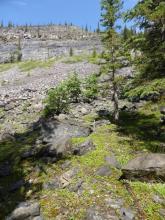
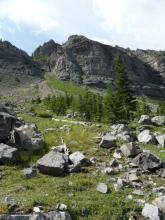
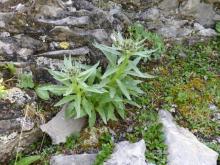
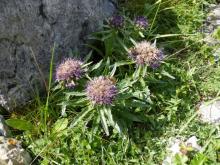
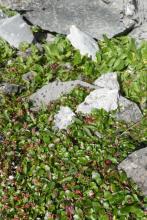
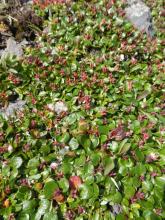
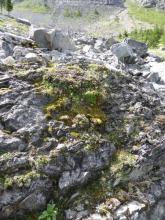
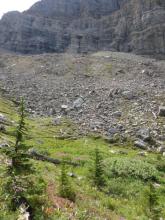
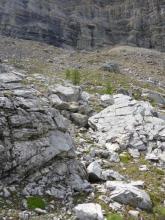







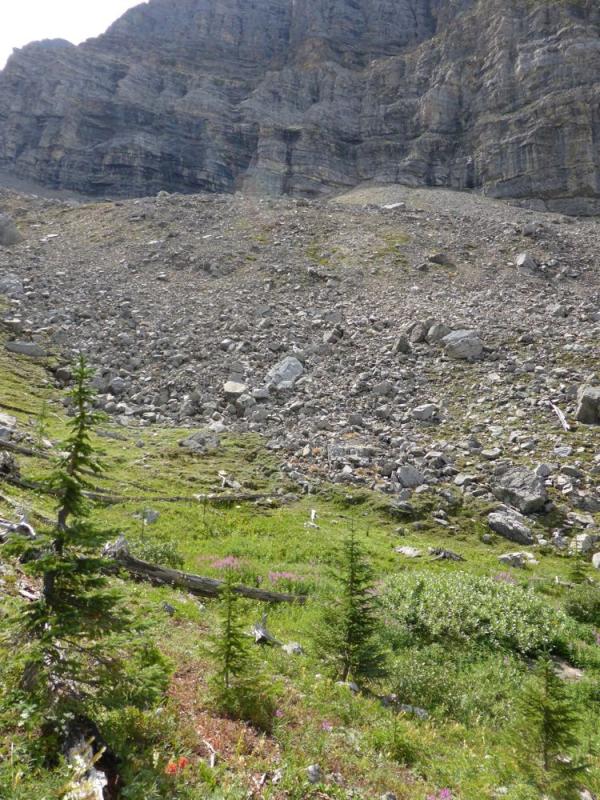
Comments
Lori S. (not verified)
Scenery, including yours
Fri, 08/09/2013 - 1:17pmScenery, including yours truly:
A little garden in a solution cavity(?) in the limestone:
Frost polygons visible in the first tarn:
Hedysarum sulphurescens:
Arnica lonchophylla and others, starting to bloom in the hanging valleys that flank the main valley:
"The stream goes underground right there." Thick growths of Saxifraga lyallii border the drainage.
Trond Hoy
Nice scenery Lori! The
Sat, 08/10/2013 - 1:35pmNice scenery Lori! The layered mountains are very similar to Svalbard's!
Lori S. (not verified)
Erigeron humilis; Erigeron
Sun, 08/11/2013 - 9:13amErigeron humilis; Erigeron aureus; Epilobium sp. (I need to figure these out); Phacelia sericea; Myosotis asiatica:
It was still early on the big scree fan (the end of our hike at ~2600m elevation) - these Epilobium latifolium were the most abundant plants in bloom; many other species were still in bud:
Geometric Silene acaulis; Veronica wormskjoldii; Crepis nana; Smelowskia calycina:
Yours truly again... the little red dot, that is:
Tarn and scenery:
deesen (not verified)
Enjoying your hike Lori,
Sun, 08/11/2013 - 12:16pmEnjoying your hike Lori, looking at pictures is my style of hiking! (I can get dizzy on a very short step ladder so mountaineering is out for me)
Richard T. Rodich
Always inspiring and
Sun, 08/11/2013 - 6:24pmAlways inspiring and educational, Lori. Thanks!
Can you tell me what a frost polygon is? It's what I am seeing underwater in that tarn, right?
Have you investigated the flora at the top of the talus slopes, where the talus meets the mountain cliffs? I see a lot of vegetation there where I assume water is more plentiful and more constant at or near the surface. Is this biom drastically different from at the base of the talus slope? (If I may mutilate one of your photo, blue arrow versus red arrows.)
Toole (not verified)
Nice pics Lori.
Sun, 08/11/2013 - 10:32pmNice pics Lori.
Myosotis asiatica looks a beauty.
Lori S. (not verified)
RickR wrote:
Mon, 08/12/2013 - 9:40pmTo those who have commented, thanks for looking!
David, rest assured that I am no mountaineer either - not even brave enough to be much of a scrambler, I'm afraid! These hikes are my speed.
[quote=RickR]
Can you tell me what a frost polygon is? It's what I am seeing underwater in that tarn, right?
[/quote]
I don't think I can tell you anything more about it (in fact, much less!) than this Wikipedia entry could:
http://en.wikipedia.org/wiki/Patterned_ground
Here's a better (zoomed in) photo:
[quote=RickR]
Have you investigated the flora at the top of the talus slopes, where the talus meets the mountain cliffs? I see a lot of vegetation there where I assume water is more plentiful and more constant at or near the surface. Is this biom drastically different from at the base of the talus slope? (If I may mutilate one of your photo, blue arrow versus red arrows.)
[/quote]
One year, I noticed some sedges(?) with black inflorescences in those areas - not a species I've noted elsewhere in this valley, but not unique. Can't say I have slogged up to those exact spots though. I have gone up to the rocky crag where the main snowmelt drainage comes out, above that spot (narrowest part of the scree fan between the rock bands on either side), and seen the same plants as elsewhere in the valley. But who can say for sure what might be therewithout having gone there?
One of the denizens of the alpine zone, a marmot:
Rich growth of Epilobium sp., Parnassia fimbriata and Saxifraga lyallii along the snowmelt drainage:
Finishing off with a few more flowers... native Taraxacum sp. (this one's for you, Cohan! :-) ; another Phacelia sericea; Senecio lugens; Solidago multiradiata... and the view: